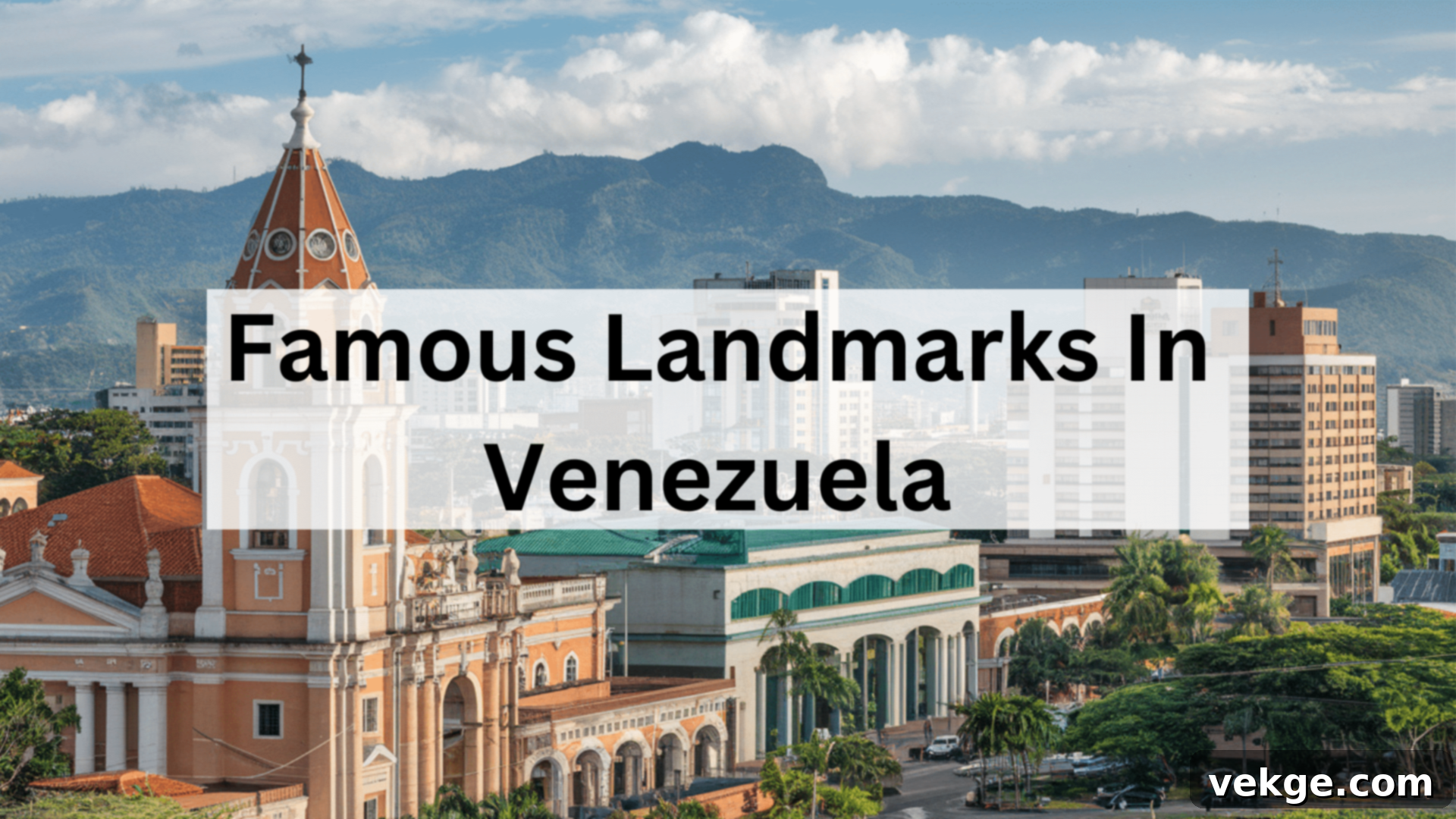Discovering Venezuela’s Architectural Gems: A Journey Through History, Culture, and Iconic Landmarks
Venezuela’s architectural landscape offers a captivating window into the nation’s vibrant history, diverse cultural influences, and remarkable structural evolution. From the enduring charm of Spanish colonial buildings to the bold statements of modernist creations, these structures serve as tangible chronicles of Venezuela’s political transformations and social developments across centuries. The country’s built environment is a fascinating fusion of European traditions, meticulously adapted to local conditions and showcasing innovative solutions designed for its tropical climate.
This comprehensive guide invites you on a journey through Venezuela’s most famous landmarks. We will explore everything from historical and colonial masterpieces that whisper tales of independence, to revered religious sites that stand as spiritual bastions, and finally, to impressive modern structures that continue to sculpt the nation’s contemporary identity. Each building not only holds a fragment of Venezuela’s rich past but also provides a deeper, more nuanced understanding of its profound architectural heritage and its unique place in Latin American design.
Historical and Colonial Buildings
Venezuela’s historical and colonial architecture is more than just a collection of old buildings; it is a vital record of the nation’s formative years. These structures vividly demonstrate the profound Spanish colonial influence that took root from the 16th century onwards, intertwining European design principles with ingenious adaptations to Venezuela’s specific tropical climate. Characterized by robust construction, practical layouts, and a timeless aesthetic, these buildings are central to understanding the country’s foundational history.
1. National Pantheon of Venezuela – Caracas
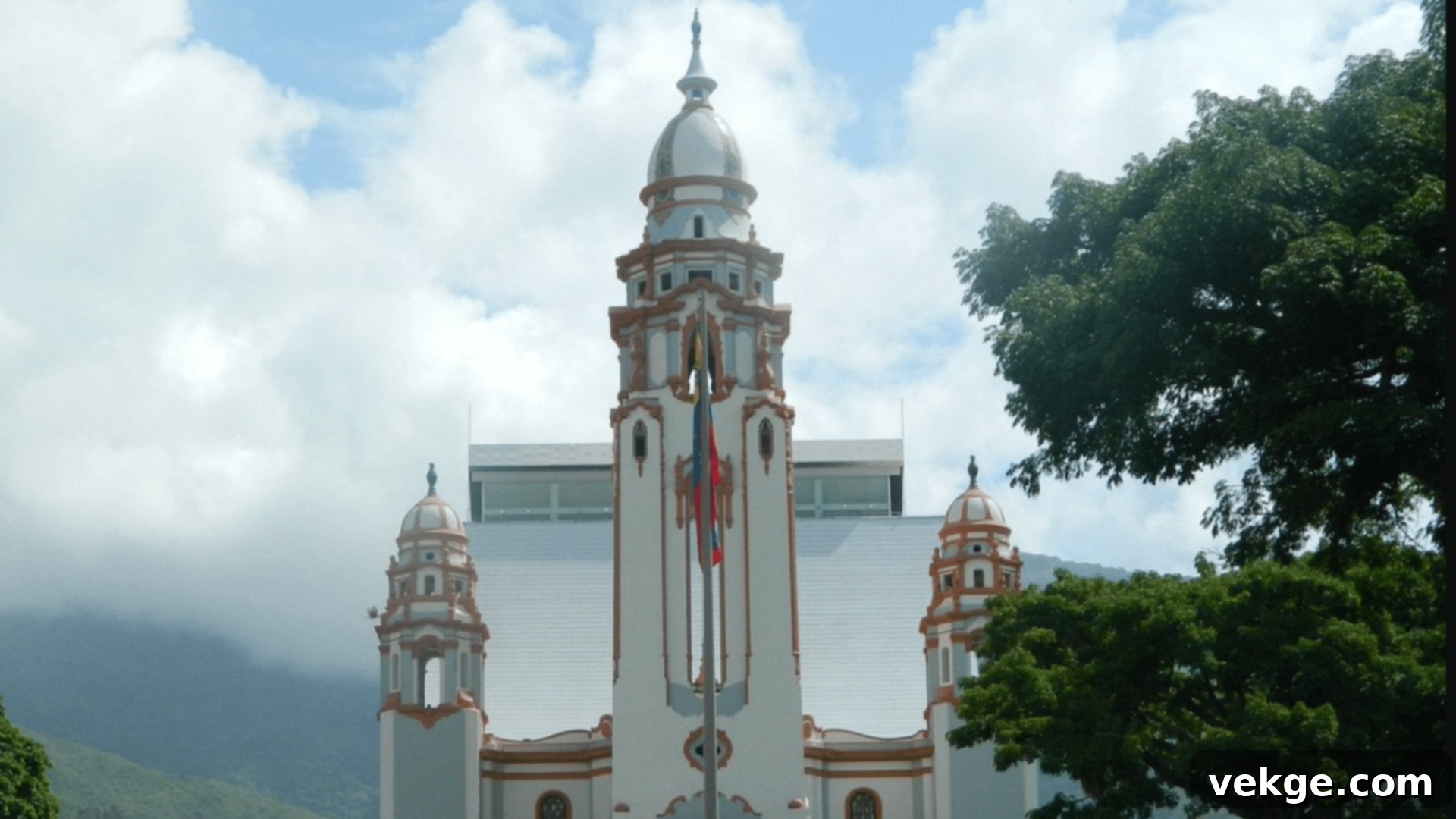
Originally consecrated as a church in the late 17th century, the National Pantheon underwent a profound transformation in the 1870s under the directive of President Antonio Guzmán Blanco. It was meticulously converted into a national monument, a sacred mausoleum intended to honor the heroes of Venezuela. Today, it stands as the solemn final resting place for Simón Bolívar, the revered liberator, alongside many other figures pivotal to the nation’s history.
Architecturally, the building boasts a stately neoclassical façade, distinguished by its balanced proportions and classical elements that evoke a sense of grandeur and permanence. The interior, however, offers a rich contrast, celebrated for its intricate marble work, particularly the meticulously carved details and polished surfaces. Furthermore, vibrant historical frescoes adorn its walls and ceilings, depicting pivotal moments and iconic figures from Venezuela’s past, effectively turning the Pantheon into a visual narrative of national pride and remembrance.
2. Simón Bolívar Birthplace House – Caracas
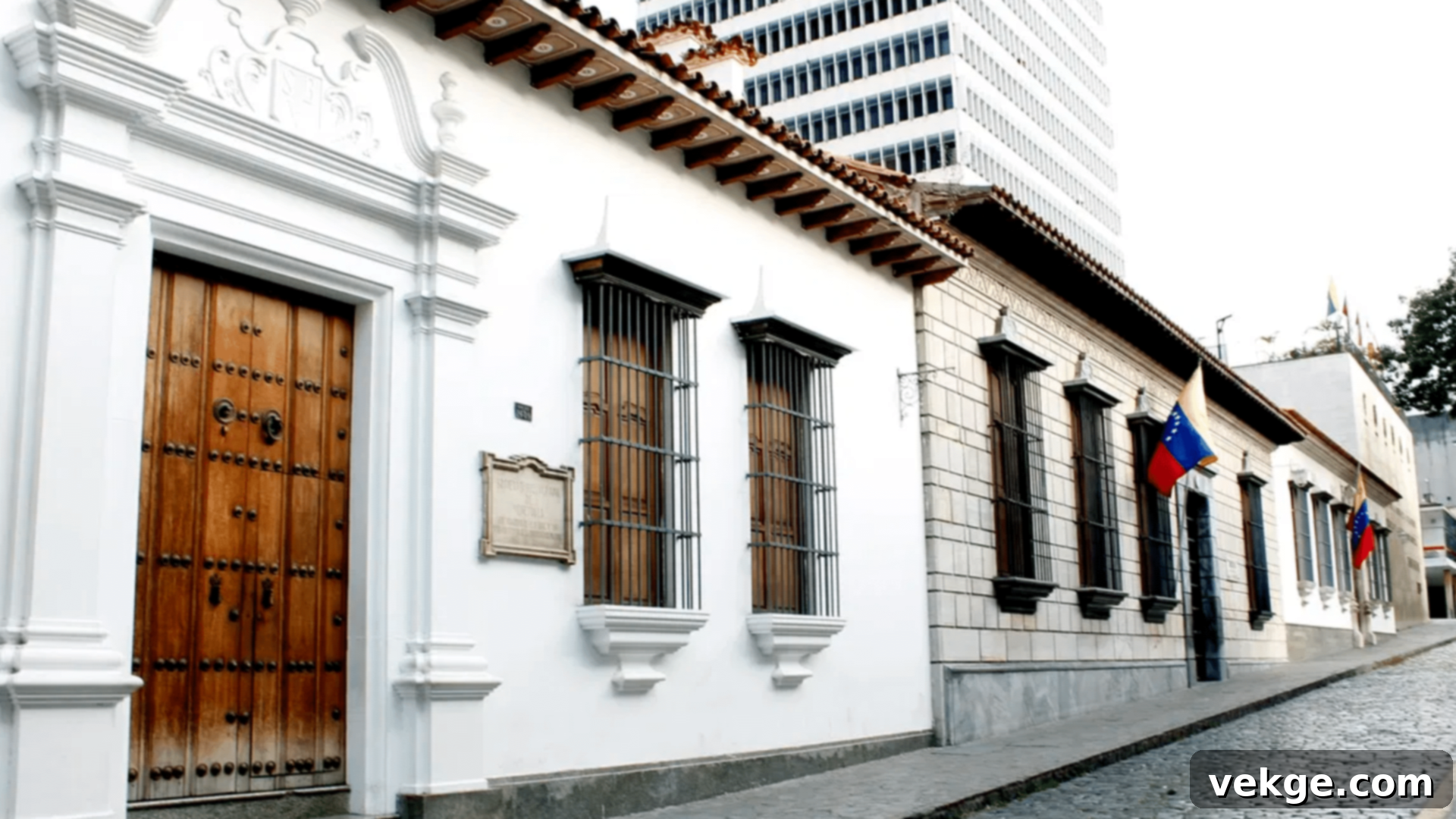
This exquisite 18th-century colonial residence holds immense historical significance as the birthplace of Simón Bolívar, the towering figure who spearheaded the liberation of Venezuela and several other South American nations. The house has been remarkably preserved, retaining much of its original structure and character, offering visitors an authentic glimpse into the life of a prominent colonial family.
Key architectural features include its signature central courtyards, which are not merely aesthetic but serve crucial functions: they provide natural light, facilitate excellent cross-ventilation, and create tranquil, shaded microclimates within the tropical heat. Now operating as a museum, the house is meticulously furnished with period pieces and personal artifacts belonging to Bolívar and his family, transporting visitors back to the era of his birth. The building’s thick, robust walls and lush, shaded gardens exemplify intelligent climate adaptations, working in conjunction with traditional clay tile roofs to maintain a comfortably cool interior, even during the warmest months.
3. Casa de la Capitulación – Trujillo
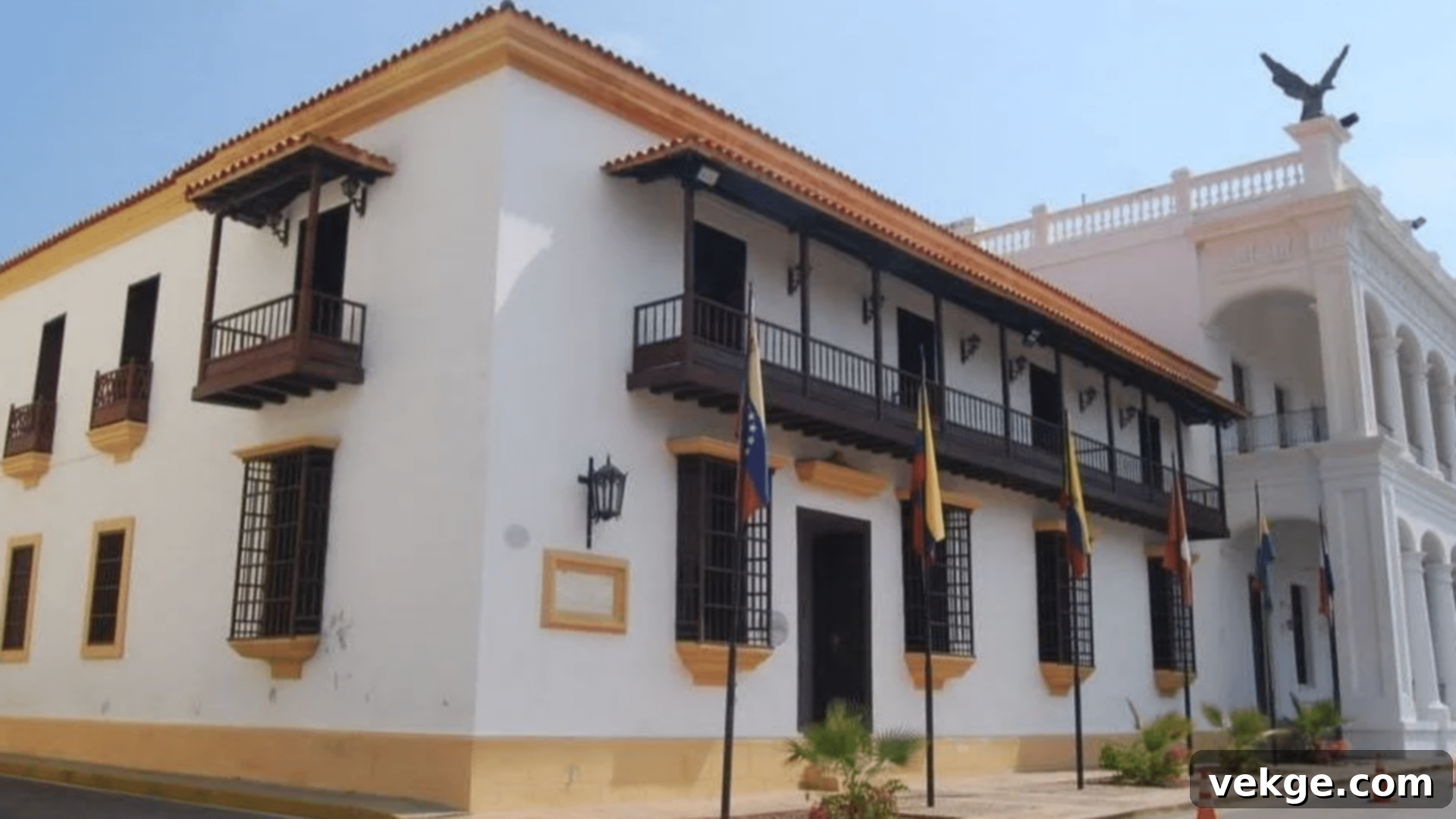
The Casa de la Capitulación in Trujillo is a profoundly historic site, immortalized as the location where Spanish forces officially surrendered to the patriot army, a pivotal moment that irrevocably turned the tide in Venezuela’s arduous struggle for independence. This building stands as a quintessential example of colonial administrative architecture, characterized by its functional yet dignified design.
Its layout typically features a symmetrical plan and a central courtyard, a common design element that provided light, ventilation, and a sense of order in public buildings. Despite a generally unassuming exterior, the interior rooms are imbued with profound national history and significance, having witnessed the negotiations that shaped the future of a nation. The structure has been carefully maintained in its original form, serving not only as a monument to independence but also as an invaluable educational site, where visitors can learn about the final moments of colonial rule and the birth of a republic.
4. Paseo Orinoco – Ciudad Bolívar
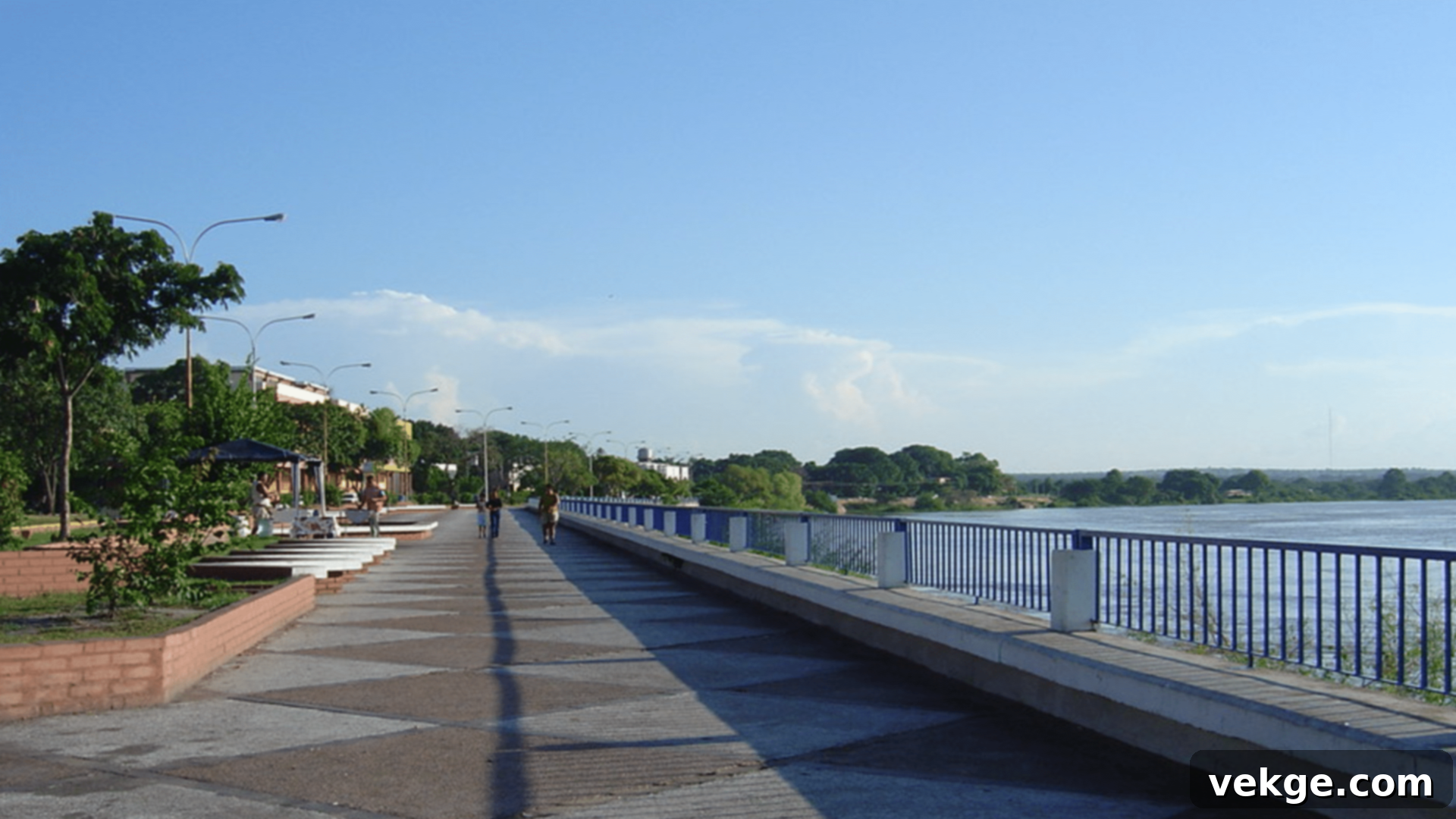
Stretching gracefully along the majestic Orinoco riverfront, Paseo Orinoco is a captivating ensemble of colonial-era buildings that once formed the bustling heart of trade and administration in Ciudad Bolívar. These picturesque structures were intricately linked to the vibrant commercial activity facilitated by the Orinoco River, serving as vital hubs for import, export, and official business. They are instantly recognizable by their distinct architectural features: brightly colored exteriors that reflect the Caribbean spirit, ornate wooden balconies that offer scenic views of the river, and characteristic louvered or shuttered windows, designed for both privacy and climate control.
The majority of these buildings date back to the 18th and 19th centuries, a period when design ingeniously merged aesthetics with functionality. They were specifically constructed to withstand and adapt to the demands of a tropical riverine environment, featuring elements that ensured airflow, shade, and protection from heavy rains, all while supporting the thriving local commerce that defined Ciudad Bolívar’s prosperity.
5. Hacienda La Vega – Caracas
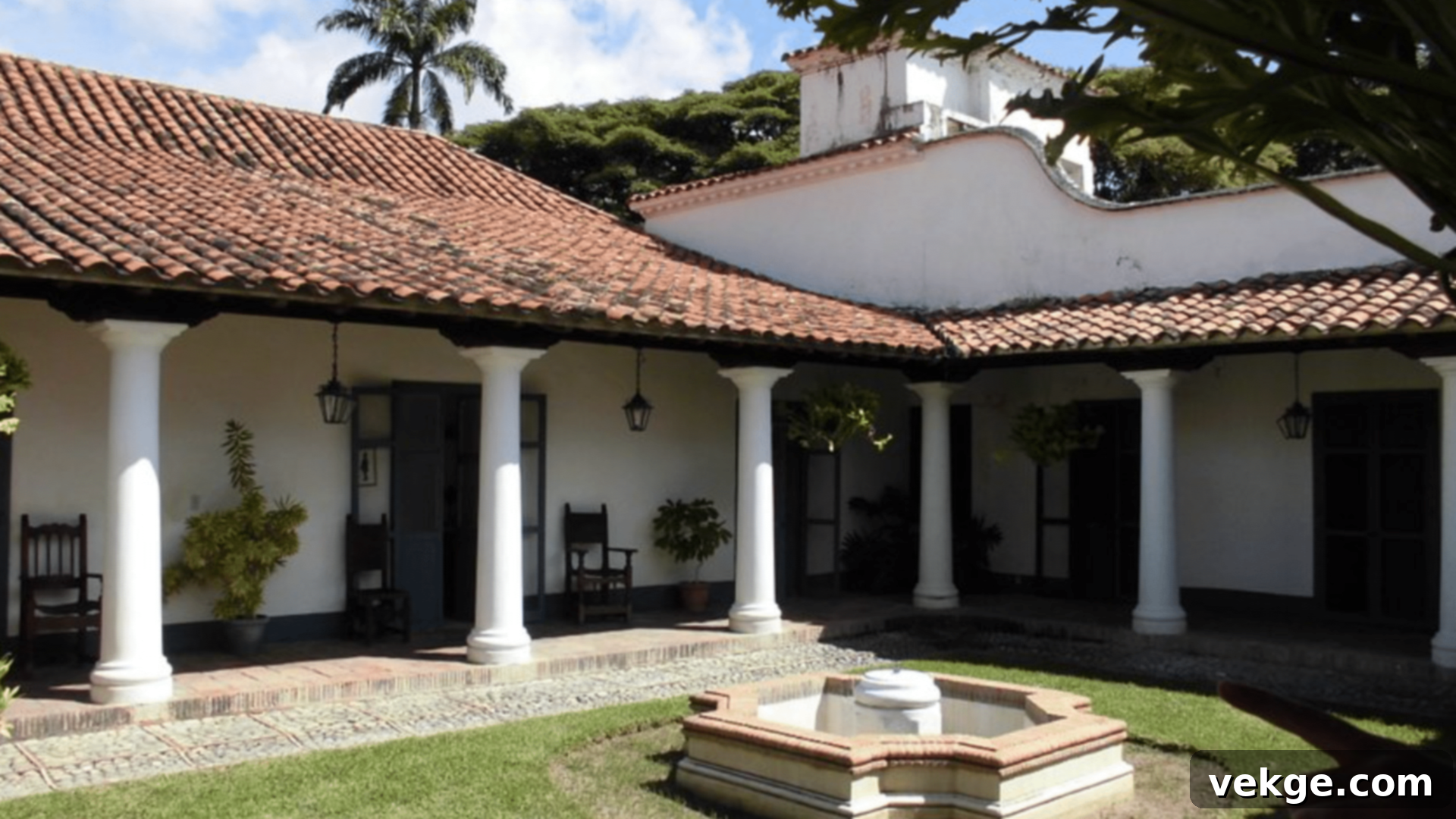
Hacienda La Vega stands as one of Venezuela’s most venerable plantation homes, with its origins tracing back to the 16th century. This sprawling estate was designed not merely as a family residence but as a self-sufficient center for agricultural production, embodying the integrated lifestyle of the colonial elite. Its architecture speaks volumes about the pragmatic yet elegant design prevalent during the era.
The hacienda’s thick adobe walls were a crucial passive climate control feature, providing natural thermal insulation that kept the interiors remarkably cool despite the tropical heat. Its thoughtful layout incorporates multiple interior courtyards and shaded walkways, expertly crafted to promote comfort through optimal airflow and provide respite from the sun. Within the hacienda complex, a beautifully preserved chapel houses rare and early examples of religious art from the colonial period, offering insights into the spiritual life of the time. The overall design masterfully reflects the intimate and intertwined relationship between farming life, community management, and domesticity that characterized plantation living in colonial Venezuela.
Iconic Religious Structures
Venezuela’s religious architecture beautifully encapsulates both the enduring legacy of Spanish colonial influence and the creative ingenuity of local adaptations. These sacred buildings transcend their role as mere places of worship; they stand as profound spiritual centers, deeply embedded within the cultural fabric and serving as prominent landmarks across the nation. Many of these structures trace their origins back to colonial times, presenting a rich tapestry of architectural styles that span various periods of Venezuelan history, each telling a story of faith, art, and community.
6. Basílica de Nuestra Señora del Valle – Margarita Island
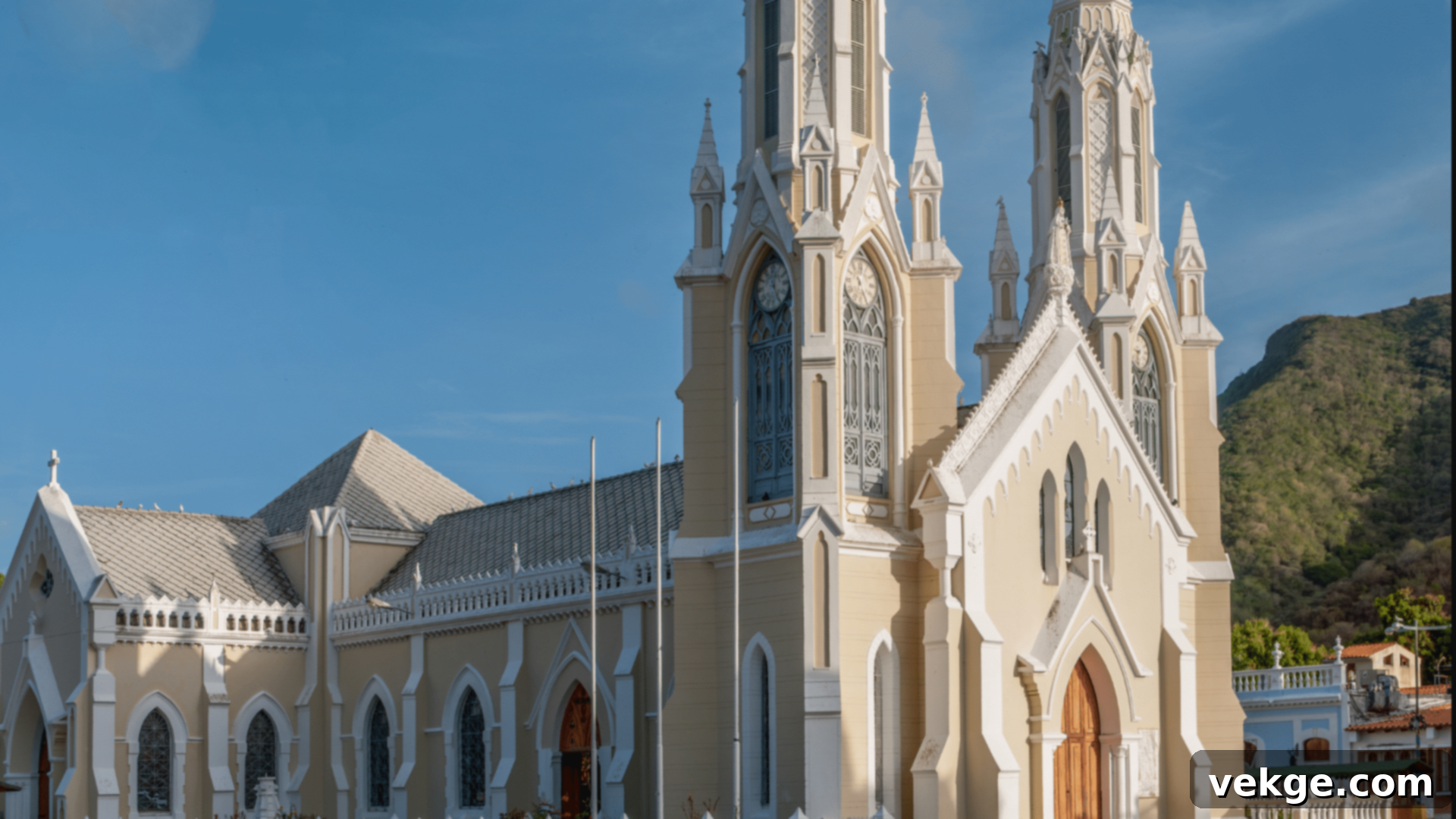
Completed in 1911, the Basílica de Nuestra Señora del Valle is not just a church; it is the spiritual heart of Venezuela’s most cherished Marian devotion, holding immense significance for Catholics throughout the country. Constructed in a majestic neo-Gothic style, characterized by its soaring arches, intricate detailing, and distinctive twin towers, the basilica commands attention and stands out as an iconic landmark along Margarita Island’s picturesque coastline.
Within its hallowed interior rests a small, revered statue of the Virgin, an image that has been honored with deep piety since the 16th century. Local fishermen, in particular, hold her in high regard, considering her their sacred protector on the often-treacherous seas. Consequently, thousands of devout pilgrims from all corners of Venezuela flock to this sacred site each year, especially during her feast day, to pay their respects, seek blessings, and express their unwavering faith, making it a powerful symbol of spiritual unity and cultural heritage.
7. Basílica de Nuestra Señora de Chiquinquirá – Maracaibo
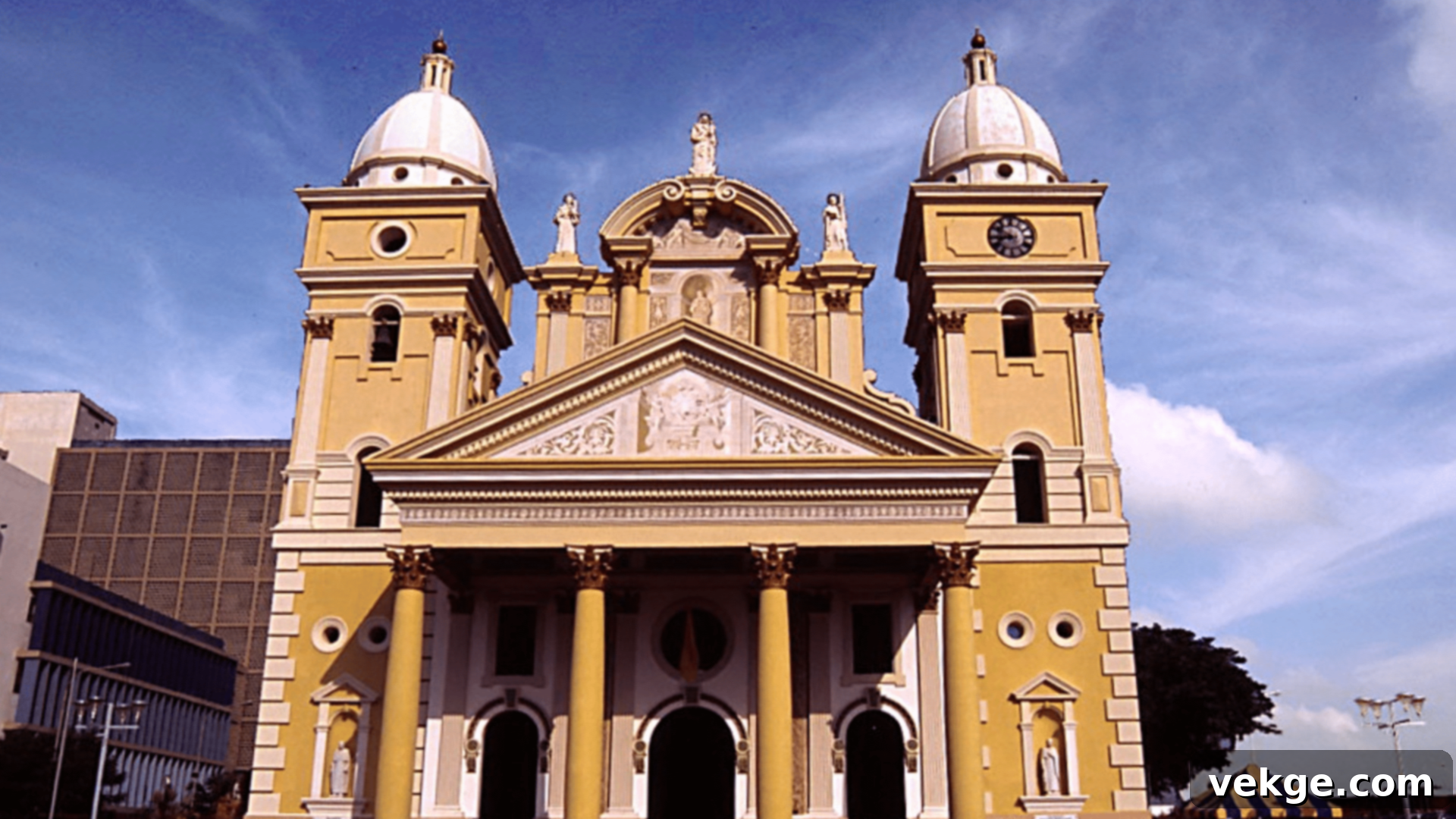
Affectionately known to Venezuelans as “La Chinita,” the Basílica de Nuestra Señora de Chiquinquirá is the revered sanctuary dedicated to the patron saint of Zulia state, holding a profound place in the hearts of its people. Erected in the early 20th century, the basilica presents a fascinating architectural synthesis, blending the elegant verticality of neo-Gothic styles with the robust, rounded forms characteristic of neo-Romanesque architecture, creating a distinctive and visually rich structure.
Its grand façade is particularly noted for a magnificent large rose window, which allows natural light to stream into the interior, illuminating the sacred space. Inside, the basilica houses a highly venerated image of the Virgin, believed by countless faithful to have appeared in a miraculous manner, solidifying its status as a site of divine intervention. Every November, the basilica becomes the vibrant epicenter of Venezuela, drawing hundreds of thousands of pilgrims and devotees for the annual celebration in honor of La Chinita, transforming Maracaibo into a bustling hub of spiritual devotion and cultural festivity.
8. Cathedral of Barquisimeto – Barquisimeto
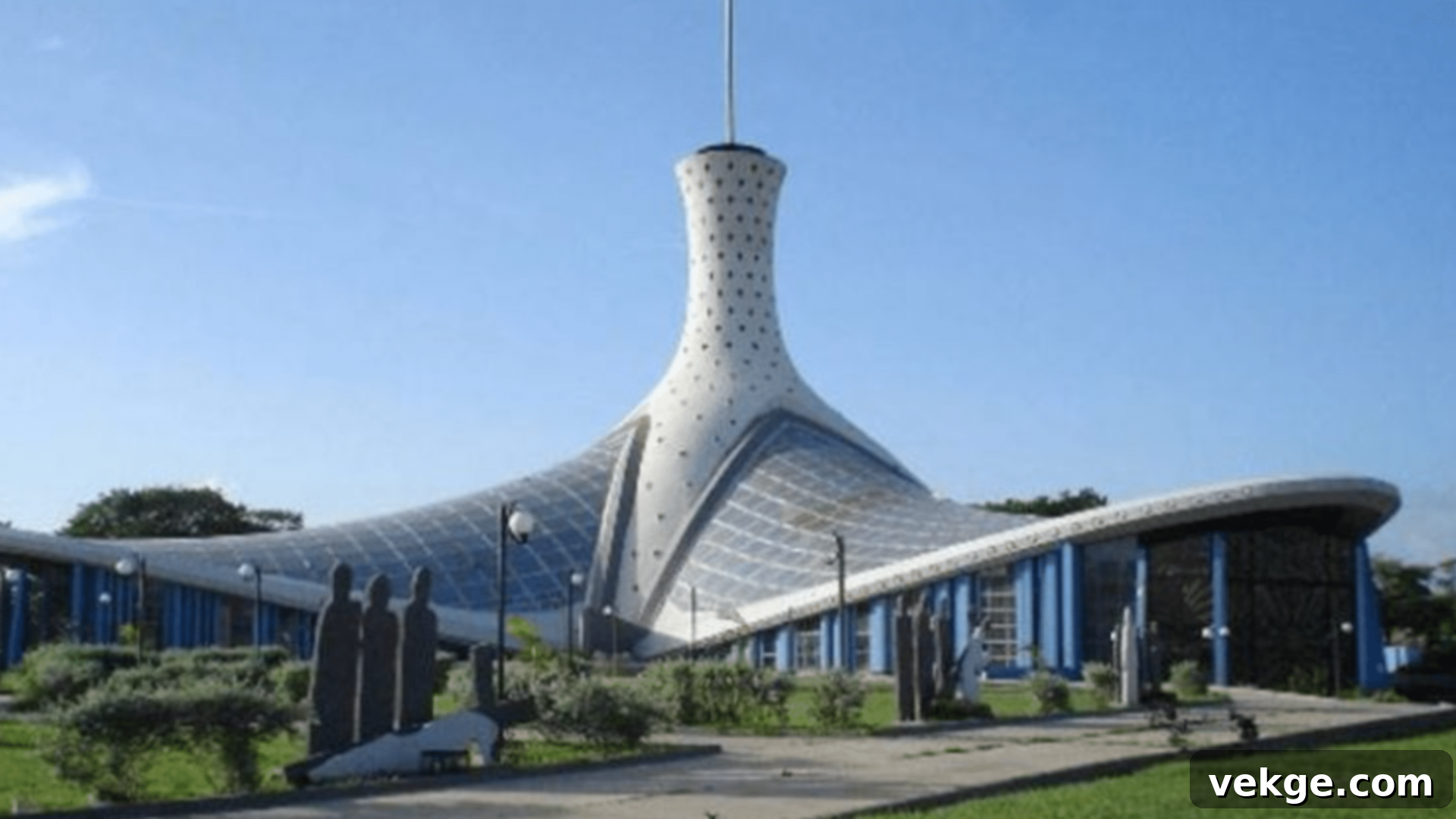
Constructed between 1953 and 1968, the Cathedral of Barquisimeto stands as a bold and compelling example of modern religious architecture, marking a significant departure from traditional ecclesiastical designs. Conceived by the visionary architect Jahn Bergkamp, its striking design features a remarkable 75-meter hyperboloid tower that majestically rises above the city, making it an unmistakable landmark visible from virtually every corner of Barquisimeto.
The interior of the cathedral is a masterful exploration of concrete, innovatively shaped to control and sculpt natural light, creating an ethereal and contemplative atmosphere within the sacred space. This avant-garde structure is dedicated to Our Lady of Coromoto, recognized as the patroness of Venezuela, and its groundbreaking design powerfully symbolizes a forward-thinking approach to spirituality and architecture. It proudly represents a decisive move away from conventional church styles, embracing innovation and modernity to create a space that is both spiritually resonant and architecturally groundbreaking.
9. Iglesia de la Candelaria – Caracas
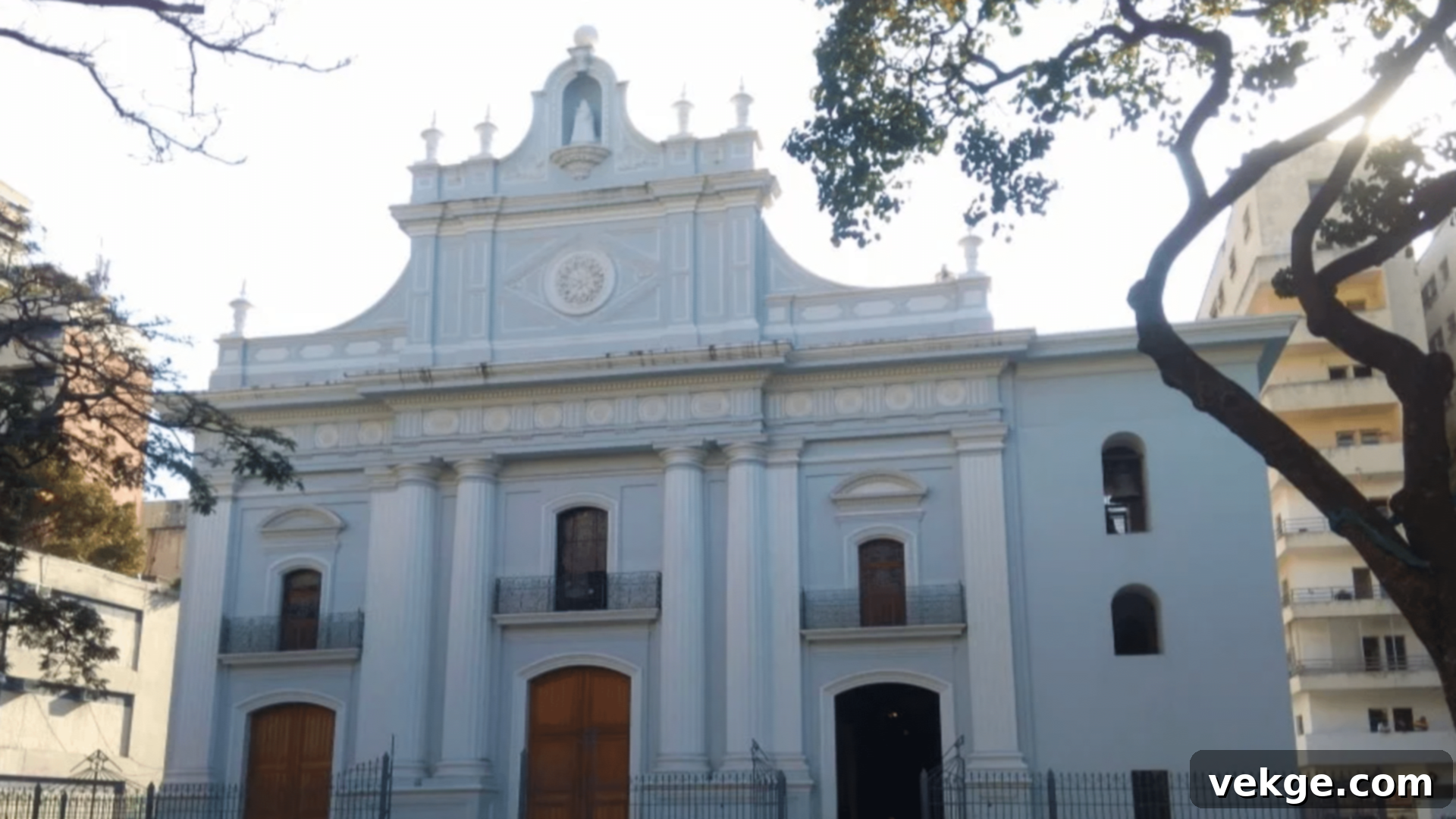
Erected in the 1700s, the Iglesia de la Candelaria holds deep historical and cultural resonance, notably named after the patron saint of the Canary Islands. This designation beautifully highlights the enduring cultural links and shared heritage between Venezuelans and Canary Islanders, many of whom migrated to Venezuela during the colonial era and later periods. Architecturally, the church showcases an elegant Baroque façade, subtly infused with classical touches, demonstrating a harmonious blend of decorative exuberance and restrained symmetry.
The interior is thoughtfully structured with three naves, gracefully divided by a series of arches that guide the eye towards the altar. Within these sacred walls, visitors can discover a collection of valuable religious artworks, including altarpieces, sculptures, and paintings that span centuries of devotion and artistic expression. Remarkably, the church distinguished itself by remaining structurally intact after the devastating 1812 earthquake, which wrought widespread destruction across Caracas, a testament to its robust construction and enduring presence in the city’s history.
10. Iglesia de San Francisco – Caracas
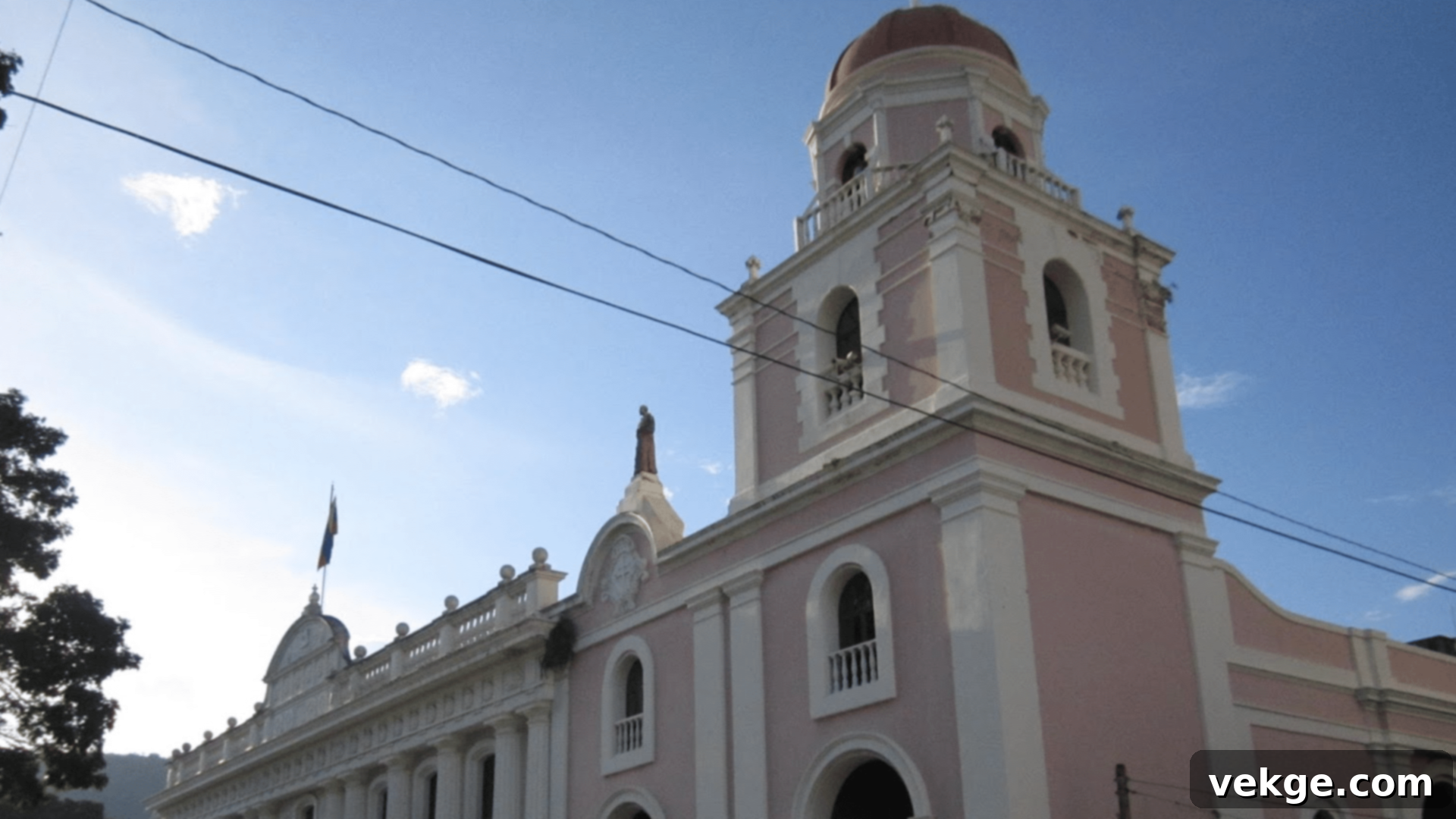
Dating back to the 17th century, the Iglesia de San Francisco in Caracas is a venerable institution of immense religious and national importance. This historic church is forever etched into the annals of Venezuelan history as the hallowed site where Simón Bolívar, the revered Liberator, was officially bestowed with his iconic title in 1813. Architecturally, the structure is a compelling synthesis of Baroque and neoclassical elements, reflecting different periods of construction and stylistic evolution.
Its distinctive bell tower, a prominent feature of the Caracas cityscape, serves as an easily recognizable landmark. Inside, visitors are greeted by a breathtaking golden altar, gleaming with intricate details, and exquisite wooden ceiling work that showcases the masterful craftsmanship of colonial artisans. Despite enduring several major earthquakes over the centuries, the Iglesia de San Francisco has remarkably maintained its structural integrity, standing resiliently as a powerful symbol of both unwavering faith and profound historical memory, continuing to be a cherished historical site for locals and visitors alike.
Modern and Cultural Buildings
The 20th and 21st centuries marked a period of profound and dynamic architectural development in Venezuela, largely fueled by periods of economic prosperity. This era saw the emergence of modern buildings across the country, showcasing a sophisticated blend of international architectural influences and a burgeoning sense of local identity. These structures not only represent Venezuela’s economic growth but also embody its ambitious cultural aspirations and its bold artistic vision, pushing the boundaries of design and urban development.
11. Monumento Manto de María – Barquisimeto
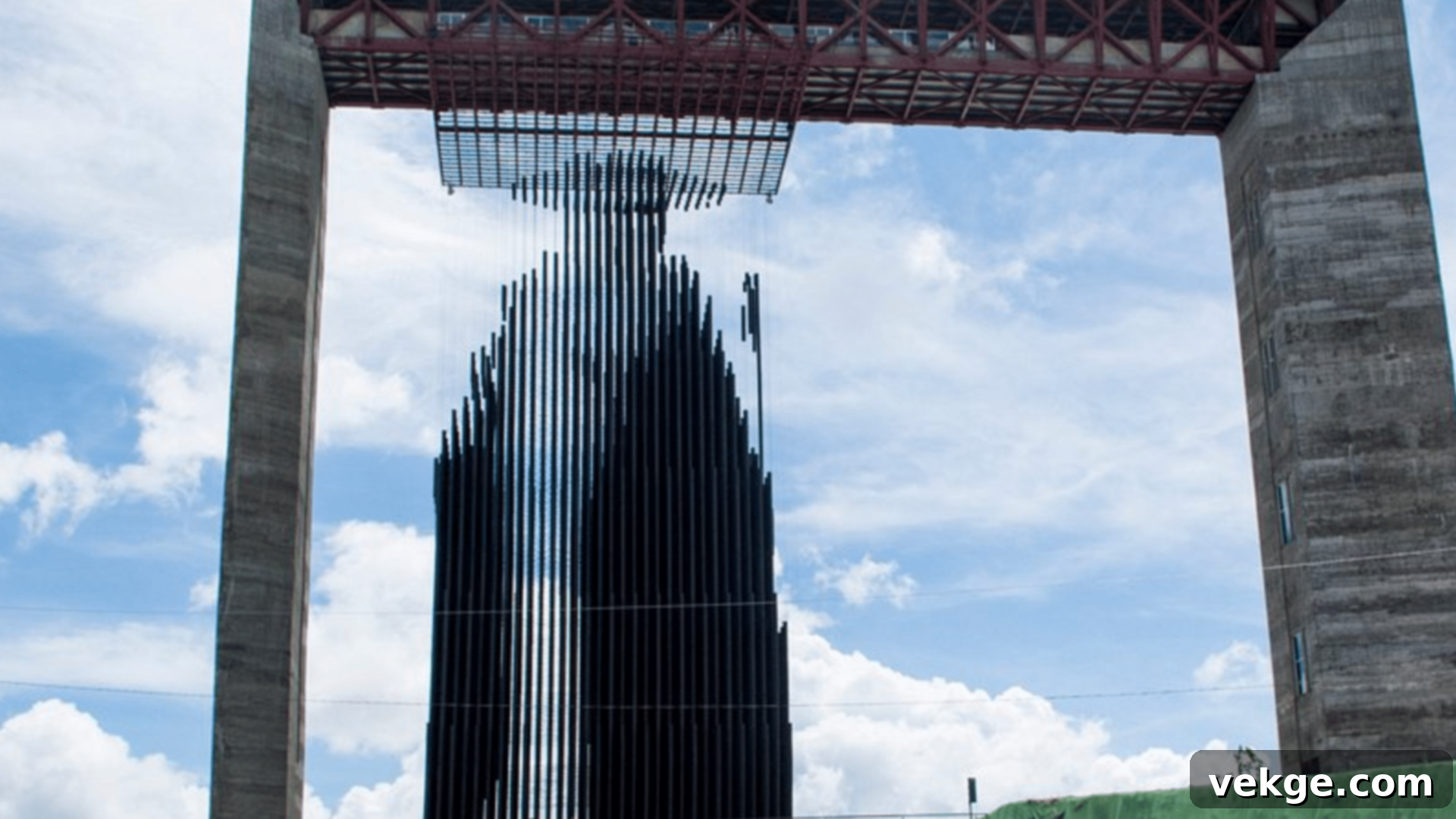
Completed in 2016, the Monumento Manto de María is a striking and emotionally resonant architectural masterpiece in Barquisimeto. Standing an impressive 63 meters tall, this monumental work was designed by the acclaimed Venezuelan architect José Abreu León. It is profoundly dedicated to Our Lady of Coromoto, Venezuela’s revered patroness, and its design eloquently captures this devotion through its form.
The monument features a graceful concrete structure that evokes the flowing drapery of a cloak, symbolizing the protective mantle of the Virgin Mary. Its immense scale and unique silhouette make it visible from numerous vantage points across Barquisimeto, quickly establishing it as a new and iconic city landmark. Situated on Loma de Guarico hill, the monument also incorporates an interior chapel, seamlessly blending deep religious significance with cutting-edge contemporary design. This thoughtful integration offers a unique and powerful fusion of spiritual devotion and modern architectural expression, inviting contemplation and admiration.
12. La Flor de Venezuela – Barquisimeto
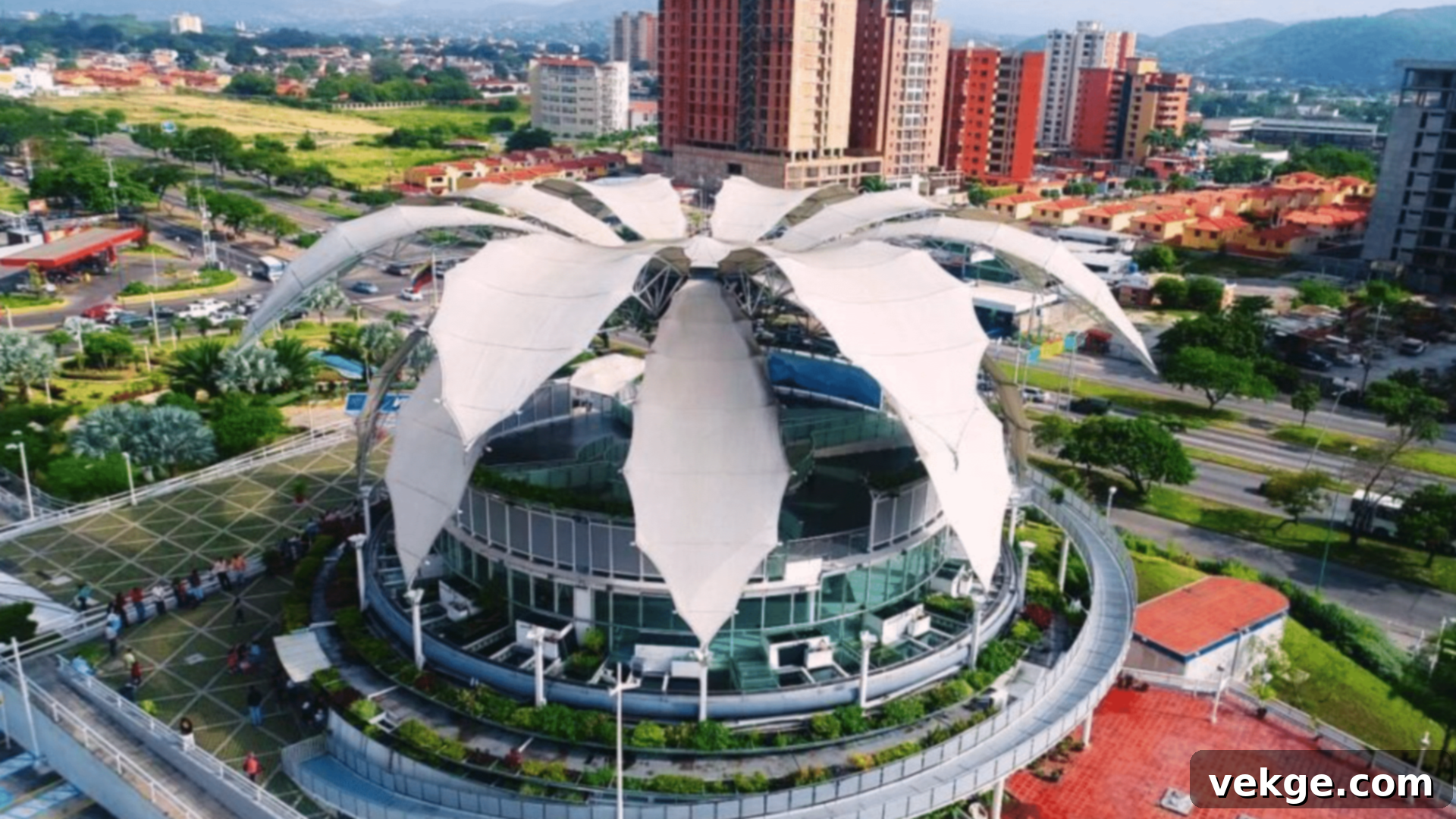
Originally conceived for Expo Seville in 1992 and later meticulously reconstructed in Barquisimeto, La Flor de Venezuela is an extraordinary example of kinetic architecture, a testament to the innovative vision of its designer, Fruto Vivas. This captivating structure is an architectural marvel that mimics a giant flower, ingeniously designed to open and close its “petals,” symbolizing the dynamic beauty of Venezuela’s natural world.
Crafted from a combination of steel, aluminum, and polyester, the monument is a triumph of engineering and artistic expression. When fully unfurled, its petals span an impressive 39 meters, revealing intricate exhibition spaces housed within. The mechanism behind its movement is a sophisticated hydraulic system, allowing the petals to gracefully articulate and transform the structure’s appearance. Representing Venezuela’s rich biodiversity and natural splendor through its unique design, La Flor de Venezuela functions as both an iconic national monument and a vibrant cultural center, drawing visitors with its innovative form and engaging exhibits.
13. Centro de Arte Los Galpones – Caracas
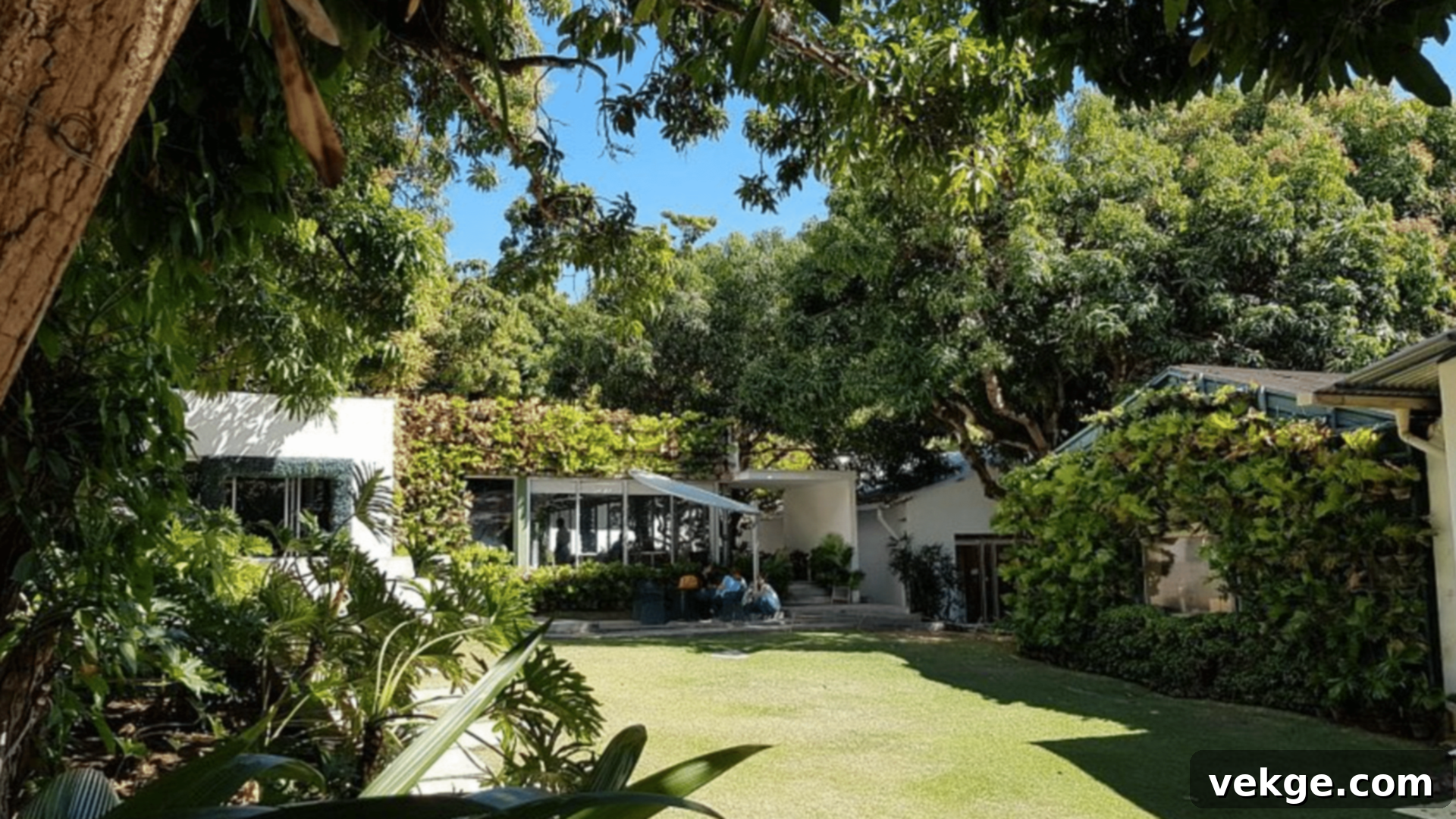
Transformed from a series of industrial warehouses in 2005, the Centro de Arte Los Galpones has emerged as a thriving cultural hub situated in the eastern district of Caracas. This remarkable adaptive reuse project showcases how existing industrial architecture can be creatively reimagined and revitalized for new purposes. The once utilitarian structures have been skillfully converted into dynamic cultural venues, providing a raw yet refined backdrop for contemporary art and expression.
The center now proudly houses multiple art galleries, artist studios, and cultural areas, fostering a vibrant environment for artistic creation and appreciation. Its design thoughtfully incorporates open central areas that seamlessly connect different exhibition spaces, encouraging exploration and interaction. By hosting a diverse range of contemporary art exhibitions, workshops, and cultural events, Centro de Arte Los Galpones has cemented its status as an indispensable component of Caracas’s cultural landscape, powerfully demonstrating how repurposed buildings can significantly revitalize urban spaces and infuse them with new artistic life.
14. Palacio de Miraflores (Presidential Palace) – Caracas
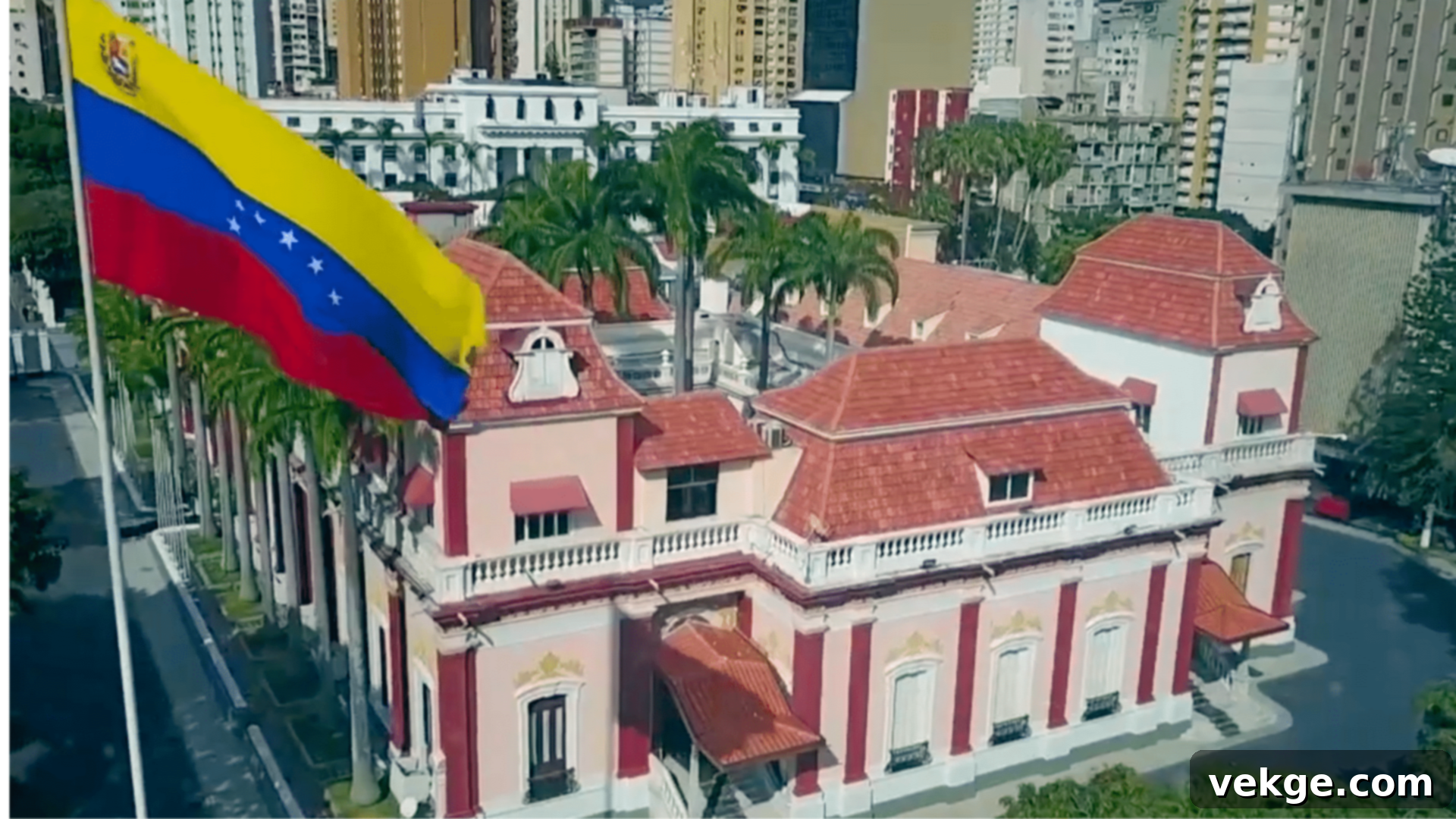
Constructed between 1884 and 1898 under the architectural guidance of the Italian designer Luciano Orsini, the Palacio de Miraflores serves as the distinguished official workplace and primary residence of Venezuela’s president. This grand edifice exemplifies neoclassical architecture, subtly infused with local adaptations that give it a unique Venezuelan character. Its pristine white façade has become an enduring and iconic symbol within Venezuelan politics, instantly recognizable to citizens and observers alike.
The palace’s interior features opulent ceremonial rooms, meticulously decorated for state functions, alongside numerous government offices that hum with the daily operations of the nation. Over its long history, the structure has undergone several expansions, carefully integrating new sections while preserving its original architectural integrity. The surrounding gardens are adorned with sculptures and commemorative monuments, each telling a piece of Venezuela’s story. Throughout its existence, the Palacio de Miraflores has borne witness to countless significant moments and pivotal decisions in Venezuelan political history, solidifying its place as a living monument to the nation’s governance.
15. Teresa Carreño Theater – Caracas
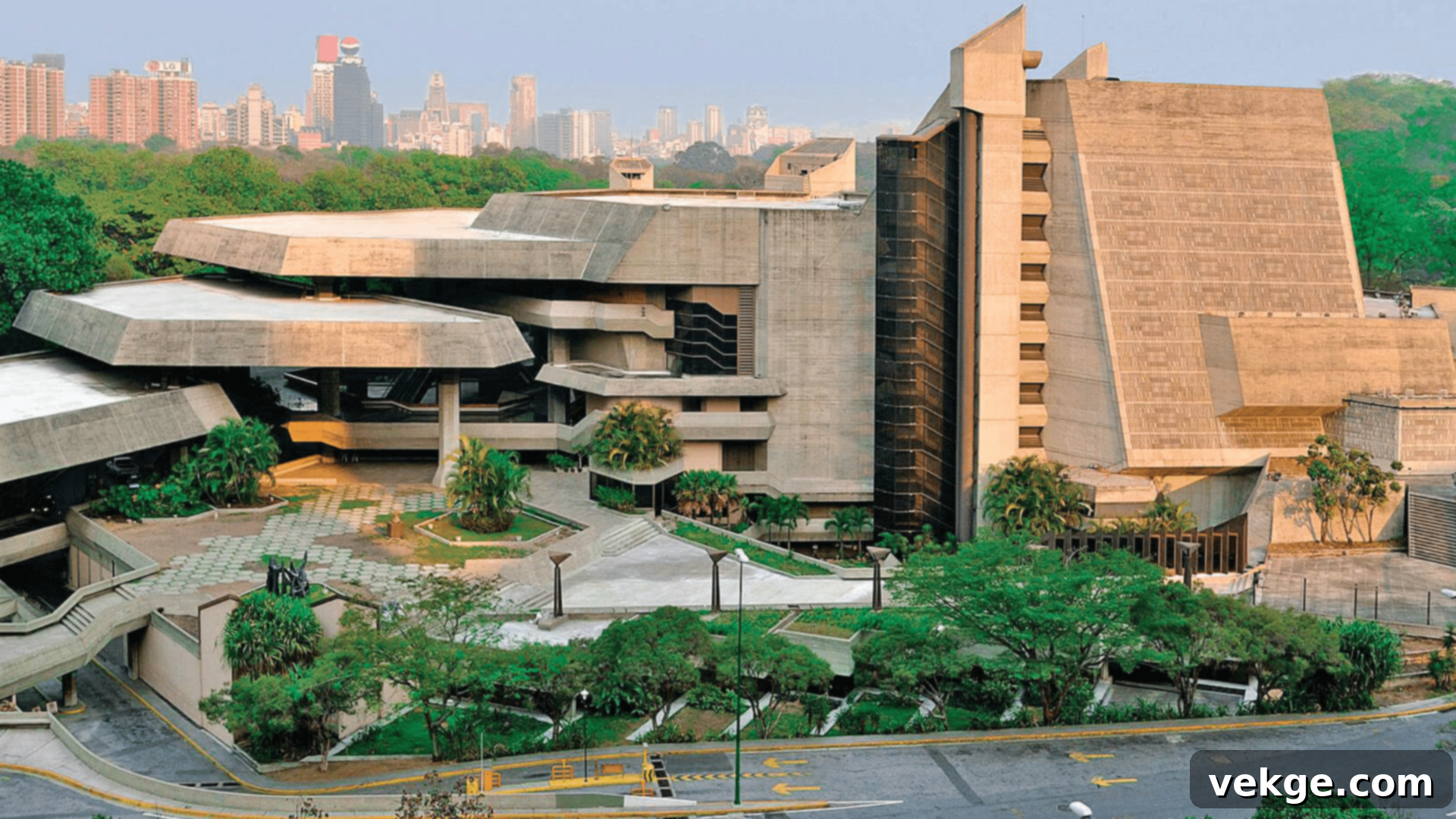
Completed in 1983, the Teresa Carreño Theater stands as one of Latin America’s most significant and largest cultural complexes, a monumental achievement in Venezuelan architecture. Designed by the Hungarian-born Venezuelan architect Tomás Lugo, this sprawling complex encompasses multiple performance spaces, with its main hall boasting a seating capacity of 2,400 people, capable of hosting grand spectacles.
The building boldly incorporates elements of Brutalist architecture, characterized by its extensive use of exposed concrete, massive forms, and a raw, honest aesthetic. However, this is expertly balanced with softer, more refined interior spaces that ensure comfort and elegance for its patrons. Constructed with a thoughtful selection of materials including concrete, vast expanses of glass, and indigenous Venezuelan woods, the theater is proudly named after the world-renowned Venezuelan pianist Teresa Carreño. It is the esteemed home of the national symphony orchestra, and its state-of-the-art acoustic design meticulously supports a wide array of performance types, from classical concerts to contemporary dance. The complex further enriches its cultural significance by integrating beautiful gardens and inviting public spaces, fostering a vibrant cultural hub within the heart of Caracas.
Forts, Castles, and Military Landmarks
Venezuela’s coastline, a strategic gateway to the Caribbean, necessitated robust defenses during the colonial era. Consequently, a series of formidable forts and castles were constructed to protect its vital coastal cities from the relentless threats of pirates, privateers, and invading forces. These enduring strongholds stand as exceptional examples of military design from that period, showcasing sophisticated engineering and strategic planning meant to secure the Spanish Empire’s interests and later, the nascent Venezuelan republic.
16. San Carlos de Borromeo Fortress – Margarita Island
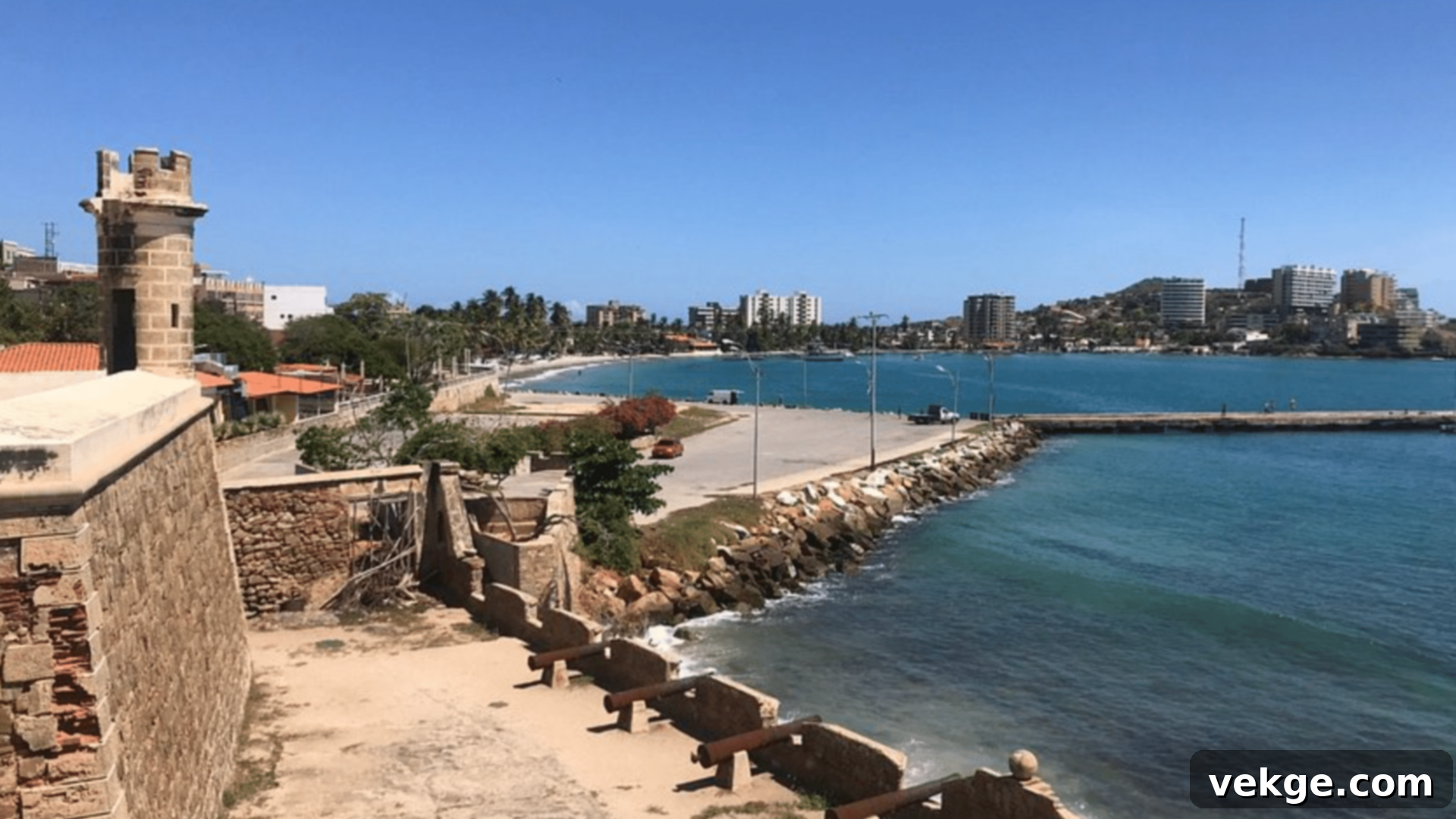
The San Carlos de Borromeo Fortress, a formidable structure, was meticulously constructed between 1664 and 1684 with the critical objective of defending Pampatar Bay, a key entry point on Margarita Island. Its design reflects advanced military engineering of the time, featuring exceptionally thick stone walls built to withstand prolonged sieges and heavy cannon fire. The fortress’s distinctive pentagonal shape was not merely aesthetic but a strategic choice, providing multiple angles for defense and maximizing defensive fire coverage.
Strategically placed cannon positions along its ramparts allowed for devastating crossfire against approaching vessels. Beyond its defensive role, the fortress notably served as a prison during the tumultuous wars of independence, holding many who fought for a free Venezuela. Today, the San Carlos de Borromeo Fortress has been transformed into a museum and proudly stands as a national monument, preserving its rich historical significance and offering visitors a tangible connection to Venezuela’s colonial and independence eras.
17. Fortín de La Galera – Margarita Island

Perched majestically on a hill overlooking the serene Juan Griego Bay, Fortín de La Galera was strategically erected in the late 1700s. Its commanding position offered unparalleled panoramic views of the coastline, making it an ideal lookout point and defensive bastion against potential invaders approaching by sea. This fort was skillfully constructed from local coral stone, a resilient and abundant material that contributed to its sturdy and enduring character.
The fort features numerous gun ports carefully integrated into its design, allowing defenders to effectively engage enemy ships while remaining protected. Crucially, Fortín de La Galera played a significant role in the independence struggle, serving as a critical stronghold for patriot forces. Since then, it has been meticulously restored to its original condition, allowing visitors to experience the authentic architectural style and defensive strategies of that pivotal historical period. It remains a poignant reminder of Venezuela’s fight for freedom.
Architectural Styles Seen in Venezuela
Venezuelan architecture is a vibrant testament to a diverse range of influences that have shaped its built environment over several centuries. The country’s structures eloquently demonstrate how global architectural movements were not merely imported but ingeniously adapted to local conditions, creating a distinctive and unique Venezuelan aesthetic. Climate, the availability of natural materials, and prevailing cultural factors were all instrumental in shaping these adaptations, resulting in a rich variety that defines different regions and eras across the nation.
Colonial Spanish Influence
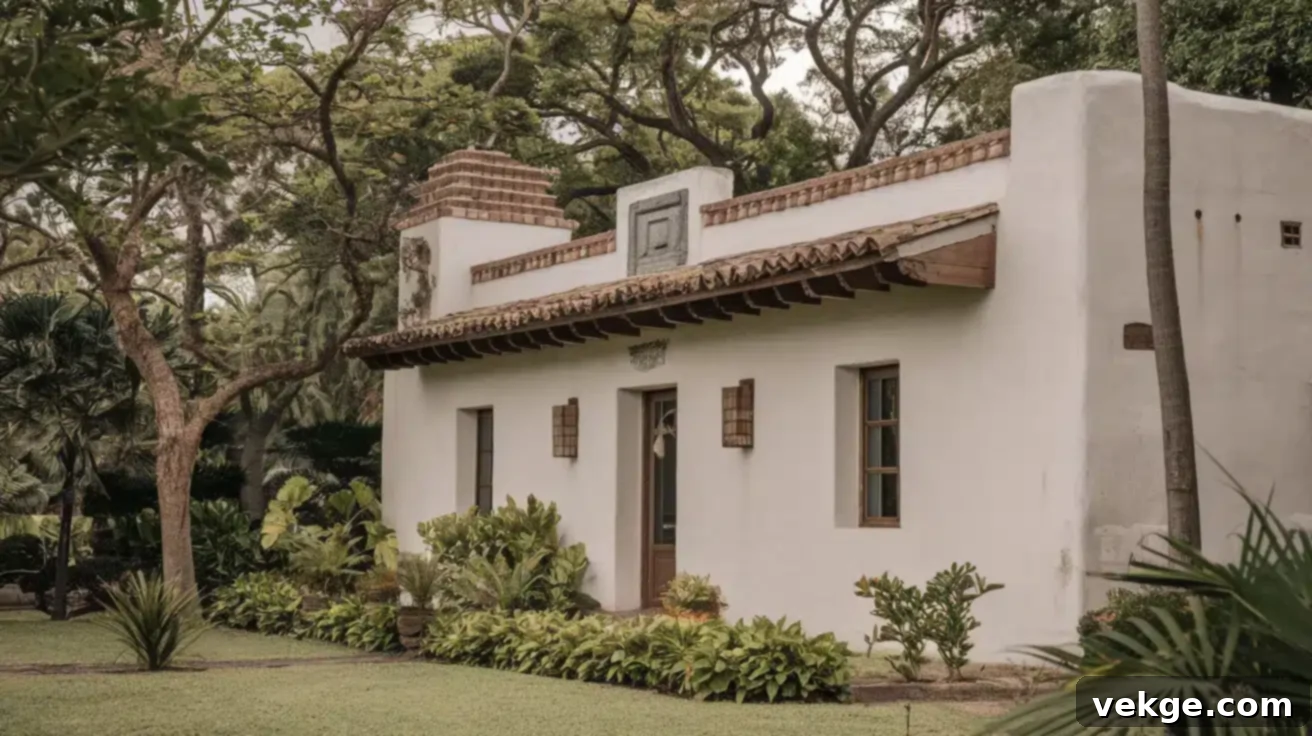
Introduced during the 16th and 17th centuries, Spanish colonial architecture in Venezuela is distinguished by its robust and practical design, primarily characterized by thick adobe walls. These walls were not only structural but also provided exceptional natural thermal insulation, effectively keeping interiors cool in the tropical heat. Homes were typically built around spacious interior courtyards, or patios, which served multiple purposes: enhancing natural light, facilitating excellent cross-ventilation, and providing private, tranquil outdoor living spaces shielded from the sun.
Clay tiled roofs were a ubiquitous feature, expertly designed with significant overhangs to efficiently manage the heavy tropical rains. Wooden balconies, often intricately carved, and latticed windows added both functional elements for shade and airflow, as well as significant aesthetic charm. While the exteriors of many residential buildings maintained a simple, unadorned appearance, their interiors often showcased more elaborate details, reflecting a private sense of artistry. Administrative buildings, befitting their importance, typically displayed more formal and imposing façades, while churches consistently stood as the most decorative and architecturally detailed structures in any colonial town, symbolizing the power and reverence of the Church. Today, the best-preserved examples of this enduring style can be admired in cities such as Coro (a UNESCO World Heritage site renowned for its colonial core), Ciudad Bolívar, and various historical districts within Caracas.
Neoclassical and Baroque Churches
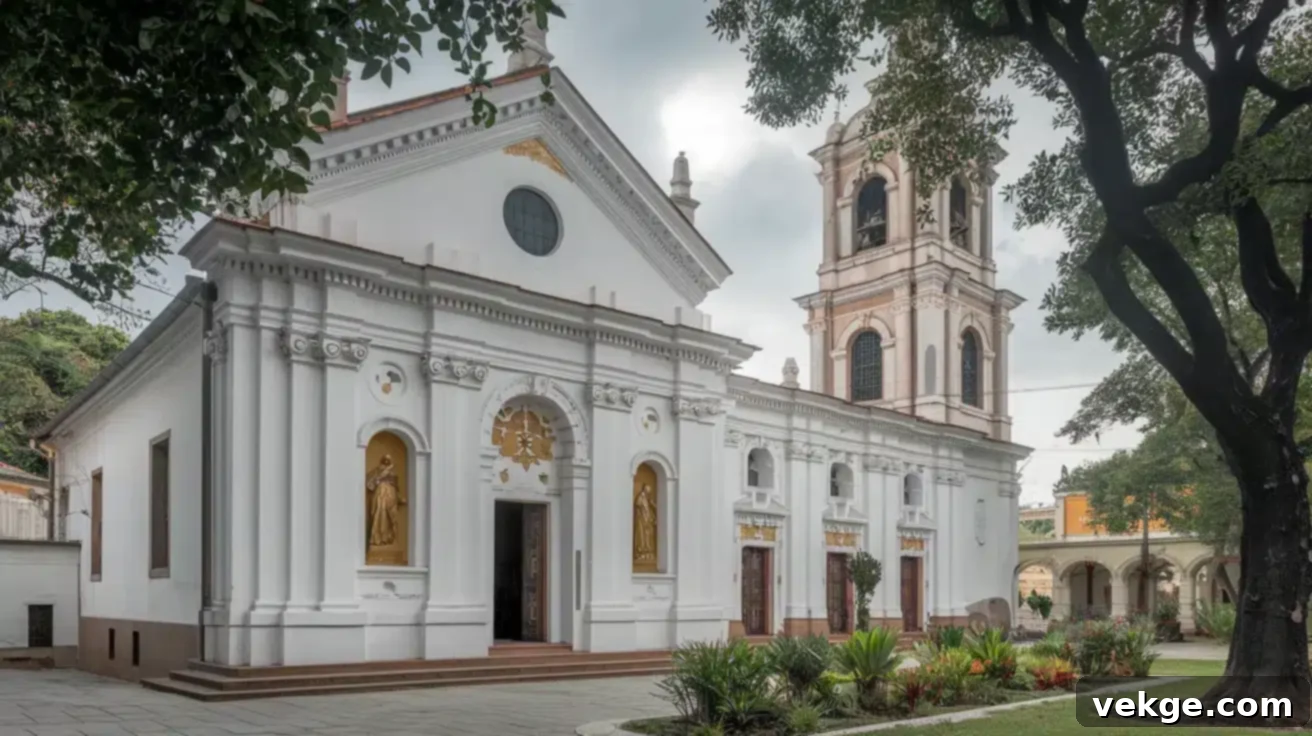
Religious architecture in Venezuela experienced significant development primarily during the 18th and 19th centuries, evolving to showcase a compelling blend of Baroque and Neoclassical styles. Baroque churches are celebrated for their ornate, theatrical details, dramatic visual contrasts, and emphasis on movement and emotion through curvilinear forms. In stark contrast, Neoclassical buildings emerged with a preference for balanced proportions, classical symmetry, and a more restrained, rational appearance, drawing inspiration from ancient Greek and Roman architecture.
Many Venezuelan churches uniquely combine elements from both styles, reflecting a transitional period and local interpretations, resulting in a distinct architectural fusion. Bell towers became defining features within cityscapes, often soaring above surrounding buildings to serve as recognizable spiritual and urban landmarks. Interiors were frequently lavishly decorated with gold leaf, intricate altarpieces, and vibrant religious artwork, creating a sense of awe and reverence. These grand structures often reflect local adaptations of European design principles, utilizing readily available materials such as native woods, local stone, and occasionally imported marble for added grandeur. This architectural richness not only symbolized the profound influence and wealth of the Catholic Church during these centuries but also highlighted the artistic and craftsmanship capabilities of the era, with notable examples found across most major cities throughout Venezuela.
Modernist and Brutalist Public Buildings
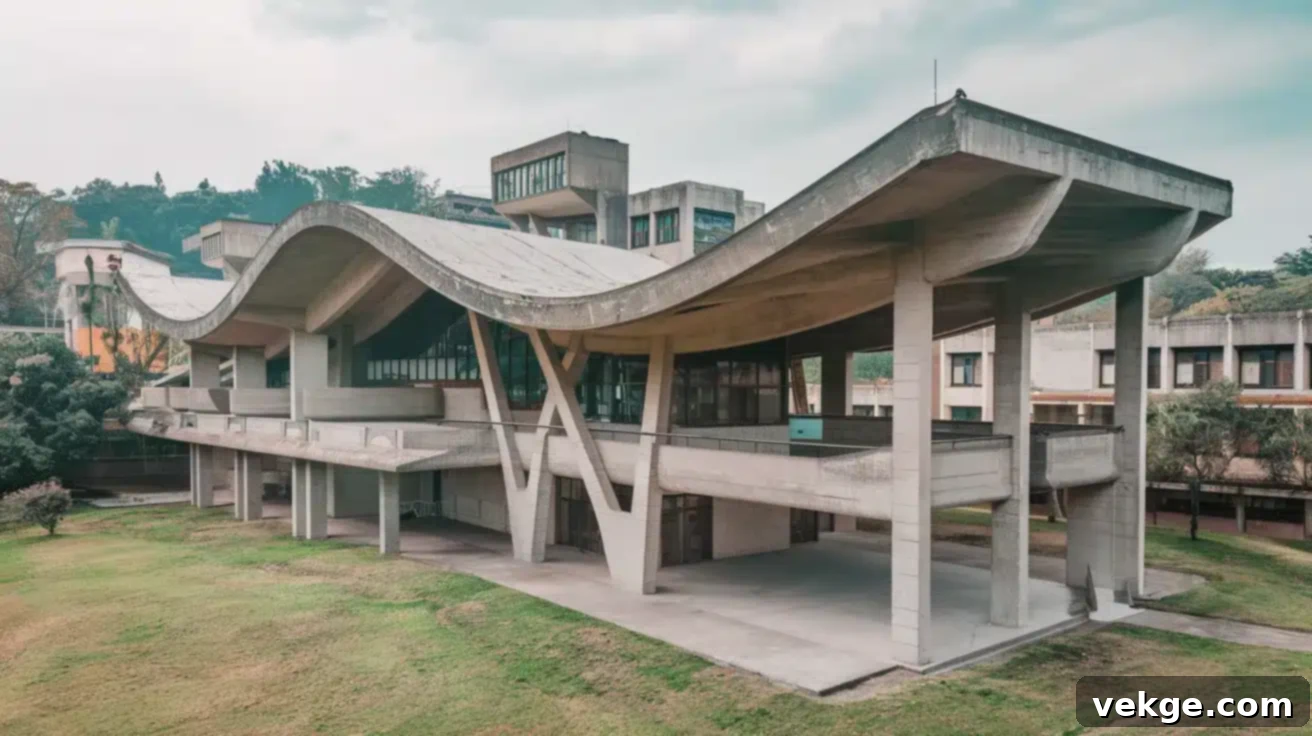
Modernist architecture in Venezuela emerged dynamically in the mid-20th century, a period fueled by the country’s burgeoning oil boom and a national aspiration for progress and modernization. This influential style is markedly characterized by its bold geometric shapes, the honest expression of exposed concrete, and an unwavering focus on functionality and technological advancement. Visionary architects such as Carlos Raúl Villanueva played a monumental role in shaping this movement, with his magnum opus, the Central University of Venezuela, standing as a prime, UNESCO World Heritage-listed example of this architectural philosophy.
These buildings were ingeniously designed to thrive within the tropical climate, frequently incorporating innovative elements like brise-soleil (sun breakers) to mitigate heat gain from direct sunlight, alongside features promoting natural ventilation and shaded walkways. A hallmark of this era was the seamless integration of art and architecture, creating spaces that were both practical and profoundly visually expressive, often featuring murals, sculptures, and kinetic art. Large open areas, dramatic cantilevered overhangs, and clean, unembellished structural lines were common features, emphasizing clarity and efficiency. Modernist design also extended ambitiously to public housing projects, where it was employed on a large scale to manifest the country’s drive toward rapid urbanization, social improvement, and overall national progress during this transformative period.
Conclusion
Venezuela’s architectural landscape is an extraordinary reflection of its rich and complex history, artistic vision, and remarkable adaptability. From the majestic colonial churches and resilient military forts that guard its past, to the striking and innovative modern structures that define its present, these buildings offer a direct and tangible link to the nation’s unfolding narrative. They are a testament to the diverse cultural influences that have shaped Venezuela, showcasing an architectural evolution that is both unique and deeply rooted.
While celebrated landmarks like the National Pantheon and the Teresa Carreño Theater are essential stops for any visitor, exploring the lesser-known sites nestled within smaller towns and rural areas can provide an even more profound and comprehensive understanding of Venezuelan cultural identity. These hidden gems often reveal local adaptations and craftsmanship that are equally compelling.
As these architectural pieces of history increasingly attract global attention, their preservation becomes not just a noble endeavor but a critical imperative. These buildings are far more than mere historical remnants; they remain active, living spaces that continue to influence, inspire, and shape community experiences across every corner of Venezuela, inviting future generations to connect with their heritage.
